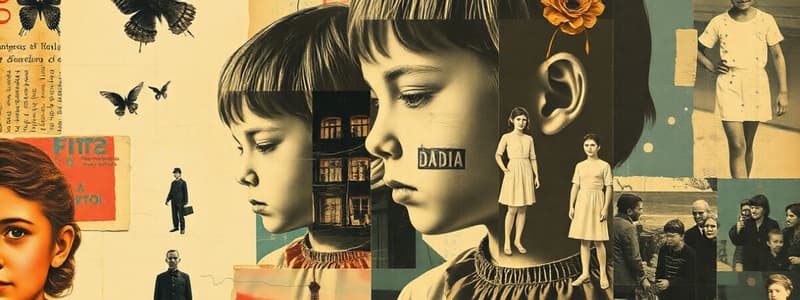Podcast
Questions and Answers
According to the study, what characteristic defines functional response classes within generalized imitation?
According to the study, what characteristic defines functional response classes within generalized imitation?
- The number of movements within each response.
- Topographical boundaries. (correct)
- The temporal order of the responses.
- The reinforcement schedule applied.
In the context of imitation studies, what does the term 'generalized imitation' refer to?
In the context of imitation studies, what does the term 'generalized imitation' refer to?
- The capacity to imitate novel behaviors without direct reinforcement, based on prior reinforcement of other imitative behaviors. (correct)
- Learning to imitate a wide variety of behaviors after training on only one specific behavior.
- Imitating behaviors displayed by a group rather than an individual.
- The tendency to imitate only behaviors that are directly reinforced.
What design was used to assess the generalization of imitation across and within response types?
What design was used to assess the generalization of imitation across and within response types?
- Alternating treatment design.
- Randomized control trial.
- AB design.
- Multiple baseline design. (correct)
In the study, what served as the basis for categorizing responses as matches or nonmatches?
In the study, what served as the basis for categorizing responses as matches or nonmatches?
What procedure was implemented for one participant, Seth, to improve matching during training trials?
What procedure was implemented for one participant, Seth, to improve matching during training trials?
What was a typical component of the 'model-and-praise' condition?
What was a typical component of the 'model-and-praise' condition?
Which of the following best describes how stimulus sets were organized in the study?
Which of the following best describes how stimulus sets were organized in the study?
Which of the following did the study specifically aim to examine regarding imitation in children with autism?
Which of the following did the study specifically aim to examine regarding imitation in children with autism?
According to Baer and Deguchi (1985), what is generalized imitation considered?
According to Baer and Deguchi (1985), what is generalized imitation considered?
What requirements did potential participants have to meet to be considered eligible for the study?
What requirements did potential participants have to meet to be considered eligible for the study?
What was the purpose of probe trials in the study's design?
What was the purpose of probe trials in the study's design?
Why did the researchers select the response types of vocal, toy play, and pantomime for the study?
Why did the researchers select the response types of vocal, toy play, and pantomime for the study?
In the description of the experimenter's behavior, what was a key aspect monitored during the sessions?
In the description of the experimenter's behavior, what was a key aspect monitored during the sessions?
According to the study, what might perseverative behavior in children with autism interfere with?
According to the study, what might perseverative behavior in children with autism interfere with?
How did the researchers ensure that a session did not start or end with a probe model?
How did the researchers ensure that a session did not start or end with a probe model?
What does the study suggest regarding the relationship between imitation and instructional control?
What does the study suggest regarding the relationship between imitation and instructional control?
According to Neef, Shafer, Egel, Cataldo, and Parrish (1983), what did their results show regarding compliance?
According to Neef, Shafer, Egel, Cataldo, and Parrish (1983), what did their results show regarding compliance?
In the study, what action was taken by experimenters if a child emitted both a matching and nonmatching response during a trial?
In the study, what action was taken by experimenters if a child emitted both a matching and nonmatching response during a trial?
According to Haring (1985) and Haring, Breen, and Laitinen (1989), what might be necessary to achieve between-class responding?
According to Haring (1985) and Haring, Breen, and Laitinen (1989), what might be necessary to achieve between-class responding?
According to the study, what was a common trend observed across the participants' data?
According to the study, what was a common trend observed across the participants' data?
Flashcards
Generalized imitation
Generalized imitation
Temporally following & topographically similar responses to behavior modeled by another person.
Generalized Imitation as Functional Response
Generalized Imitation as Functional Response
A functional response class where some imitative responding, although never directly reinforced, is maintained as long as other imitative responding is reinforced.
Imitation Subclasses
Imitation Subclasses
Imitation may be comprised of distinct subclasses defined by the topography of the imitative response.
Garcia et al. Study
Garcia et al. Study
Signup and view all the flashcards
Garcia et al. Findings
Garcia et al. Findings
Signup and view all the flashcards
Nonmatching Response
Nonmatching Response
Signup and view all the flashcards
Research Design
Research Design
Signup and view all the flashcards
High-Probability instruction
High-Probability instruction
Signup and view all the flashcards
Study Notes
Overview
- Study examines imitation in autistic children across different response types
- Analyzes imitative response classes in children with autism
Study Design
- Examines the influence of response topography on imitation generalization
- Focuses on vocal, toy-play, and pantomime responses
- Involves reinforced training and non-reinforced probe trials
Participants
- Includes four children with autism
- Utilizes a multiple baseline design
Key Findings
- Imitation generalized from reinforced to non-reinforced models within a response type
- Imitation did not generalize across response types
- Functional response classes are determined by topographical boundaries within generalized imitation
Imitation Explained
- Generalized imitation involves responses that temporally follow and are topographically similar to modeled behavior
- Imitation has a role in social behavior and language development
- Imitation may be a functional response class
Reinforcement Types
- Imitative responding can be maintained if other imitative responding is reinforced
- Non-reinforced imitative responding decreases when reinforcement stops for other imitative acts
- Imitation could consist of subclasses by topography
Participants Details
- Study includes three boys and one girl meeting DSM-III-R criteria for autism
- Ages ranged from 2 years 11 months to 4 years 5 months
- Peabody Picture Vocabulary Test and Vineland Adaptive Behavior Scales were administered
- All children were enrolled in the Princeton Child Development Institute (PCDI) education program
Imitation Evaluation
- Three children showed no imitative behavior upon entering the program
- David demonstrated some echolalic responding
- Boys had about 1 year of preliminary vocal imitation training
- The girl began vocal training concurrently with the investigation
- All children showed perseverative behavior with objects and/or some stereotypic behavior
Setting
- Study conducted in a small classroom used for one-to-one sessions
- Room equipped with tables, chairs, and a camcorder for recording
Models
- Vocal modeling stimuli included combination of words already in repertoire and new ones
- Vocal-with-toy models (for David) combined motor response with vocalization
- Toy-play models involved two to three toy movements of 45 different toys
Pantomime
- Pantomime models had motor movements resembling activities with objects/social meanings
- Examples are "blowing a kiss" or using hands to form a "telescope"
Stimulus Sets
- Two-thirds training (reinforced) models and one-third probe (non-reinforced) models within each response type
- Each of the 20 stimulus sets included 27 trials (nine vocal, nine pantomime, and nine toy-play models)
Response
- Responses were recorded as matches or nonmatches
- Toy-play and pantomime matches involved established motor movements
- Vocal matches needed all vocal components
- Data was collected from videos of each session.
- A multiple baseline was used to look at generalization of imitation across and within response types.
Experimenter
- Experimenter behavior monitored for correctness of model, presentation, order, reinforcement, etc.
- Experimenter behavior was generally scored as correct on 100% of trials
Procedure
- Sessions began with successful, praised trials
- Model-alone: experimenter said "Look at me" before target
- Model-and-praise: like model-alone, but with verbal praise and edible reinforcer/physical contact for matches
- Generalization probe: no reinforcement for matches
Seth procedure
- For Seth an instruction-following procedure was implemented consisting of two compliance models
- Matching responses following these instruction-following models were not reinforced
Response Analysis
- Vocal matching increased to 100% for Neal during training trials
- Toy-play matches increased above baseline but reached 100% during only one session for Neal during training
- Matching for toy play for Heidi, showed only a slight and inconsistent increase in matching
- Nonmatching decreased for each response type with the introduction of treatment
General Findings
- Imitation generalized only within each response type
- Nonmatching responding did not increase
- Toy-play was most slowly acquired response class
- With the instruction-following procedure, Seth's matching increased across all three response types
Discussion
- Generalized imitation may be limited by the topographical boundaries of response type - children do better when trained with models that look similar to the trained models
- Imitation generalized best within the response type
- The high-probability instruction sequence which enhanced helped Seth with treatment
- The use of requests with a high probability of compliance can sometimes increase compliance to other requests.
- Perseverative behavior affected toy play negatively
Studying That Suits You
Use AI to generate personalized quizzes and flashcards to suit your learning preferences.





